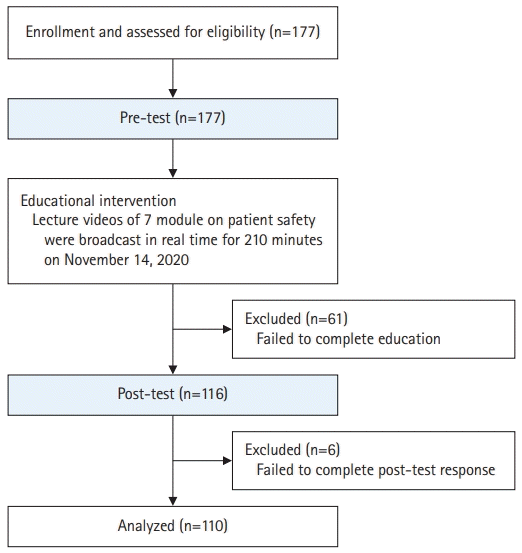2. Singh HK, Joshi A, Malepati RN, Najeeb S, Balakrishna P, Pannerselvam NK, Singh YK, Ganne P. A survey of E-learning methods in nursing and medical education during COVID-19 pandemic in India. Nurse Educ Today. 2021; 99:104796.
https://doi.org/10.1016/j.nedt.2021.104796.
7. Faul F, Erdfelder E, Lang AG, Buchner A. G*Power 3: a flexible statistical power analysis program for the social, behavioral, and biomedical sciences. Behav Res Methods. 2007; 39:175–191.
https://doi.org/10.3758/bf03193146.
8. Cohen J. The t test for means. In : Cohen J, editor. Statistical power analysis for the behavioral sciences. 2nd ed. New York (NY): Lawrence Erlbaum Associates;1988. p. 19–74.
10. Gleason KT, Commodore-Mensah Y, Wu AW, Kearns R, Pronovost P, Aboumatar H, Dennison Himmelfarb CR. Massive open online course (MOOC) learning builds capacity and improves competence for patient safety among global learners: A prospective cohort study. Nurse Educ Today. 2021; 104:104984.
https://doi.org/10.1016/j.nedt.2021.104984.
11. Pursel BK, Zhang L, Jablokow KW, Choi GW, Velegol D. Understanding MOOC students: motivations and behaviours indicative of MOOC completion. J Comput Assist Learn. 2016; 32:202–217.
https://doi.org/10.1111/jcal.12131.
12. World Bank’s EdTech Team. Remote learning, distance education and online learning during the COVID19 pandemic. Washington (DC): World Bank;2020.
https://doi.org/10.1596/33499.
13. Chipps J, Brysiewicz P, Mars M. A systematic review of the effectiveness of videoconference-based tele-education for medical and nursing education. Worldviews Evid Based Nurs. 2012; 9:78–87.
https://doi.org/10.1111/j.1741-6787.2012.00241.x.




 PDF
PDF Citation
Citation Print
Print





 XML Download
XML Download